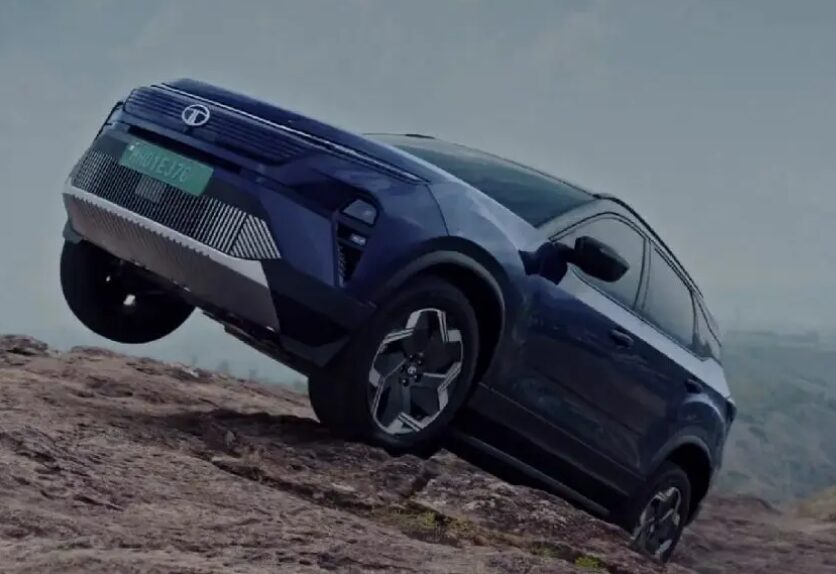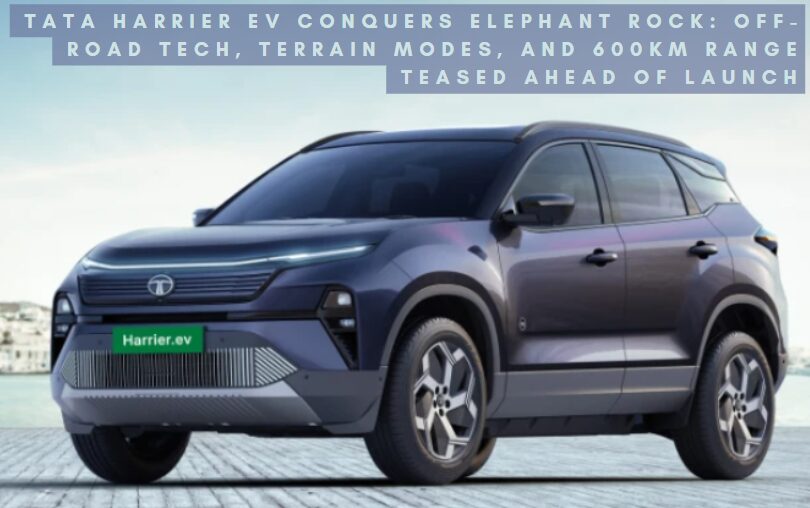Overview
- Tata Harrier EV conquers the challenging Elephant Rock in Kerala, proving its off-road prowess just a day before its official launch on June 3, 2025.
- Revealed off-road tech includes Off-Road Assist, Rock Crawl Mode, Transparent View, and Boost Mode, designed to master tough terrains effortlessly.
- Equipped with Tata’s advanced Quad Wheel Drive (QWD) dual-motor system, delivering superior traction and control on rugged surfaces.
- Teased 600 km driving range on a full charge, with instrument cluster showing up to 560 km at 90% battery—setting new standards in electric SUVs.
Introduction:
Just a day before its official launch on June 3, 2025, Tata Motors has stunned the internet by releasing an adrenaline-pumping video of the upcoming Harrier EV conquering the intimidating Elephant Rock in Kerala. Known for its rugged, almost impassable terrain and a daunting 34-degree incline, the climb is usually a nightmare even for expert trekkers—let alone a car. But the Harrier EV, armed with new-age off-road tech and a powerful Quad Wheel Drive (QWD) setup, defied the odds in spectacular fashion.

A Rock Climb That Redefines EV Adventure
In a move reminiscent of Land Rover’s legendary off-road stunts, Tata Motors showcased the Harrier EV’s raw muscle and refined engineering through this dramatic challenge. The rock face, which peaks at nearly 3,937 ft above sea level, was broken into three segments: Minefield, Ridge, and Beast—each testing a different dimension of the Harrier EV’s off-road capability.
Harrier EV’s Off-Road Arsenal – What We Know So Far
| Feature | Purpose |
|---|---|
| QWD (Quad Wheel Drive) | Dual-motor setup powering all four wheels for superior traction |
| Off-Road Assist | Adjusts torque and braking for uneven terrain |
| Transparent Mode | 360° underbody view using stitched camera feeds for better trail visibility |
| Rock Crawl Mode | Terrain Response system feature to tackle rocky inclines |
| Boost Mode | Unlocks full power output for steep climbs like the 34° inclin |
Stage 1 – Minefield:
The initial phase was filled with loose rocks and boulders. Here, the driver activated Off-Road Assist, which adjusted the torque distribution and braking automatically. The Transparent Mode, using underbody cameras, provided a real-time stitched visual feed to help navigate sharp rocks and tight spots with surgical precision.
Stage 2 – Ridge:
As the terrain worsened with deeper craters and uneven inclines, Rock Crawl Mode took over. This feature is part of Tata’s revamped Terrain Response system and enables the SUV to crawl slowly and steadily even when one or more wheels lose contact with the ground.
Stage 3 – Beast:
The final and most treacherous segment involved a staggering 34-degree incline—a serious challenge even for ICE-powered 4x4s. But Harrier EV breezed through, thanks to its Boost Mode, unleashing maximum torque instantly. This is where the QWD system truly shined, delivering equal traction across all four wheels for unshakeable grip.

Range Teaser: 600km on a Single Charge?
Tata didn’t just flex the EV’s off-road muscles—they quietly dropped a range bombshell too. In the video, the digital cluster showed:
- 560 km range @ 90% SOC
- 550 km @ 88% SOC
- 525 km @ 85% SOC
This strongly hints at a full-charge range of 600km, placing it at the top of India’s electric SUV charts.
SOC stands for State of Charge. It refers to the current battery level of an electric vehicle (EV) expressed as a percentage of its total capacity. For example, if the SOC is 90%, it means the battery is charged to 90% of its full capacity.
Conclusion
The Tata Harrier EV’s Elephant Rock climb is more than just a marketing stunt—it’s a powerful statement. This isn’t just an EV built for the city or highway; it’s one engineered for adventure, capable of tackling India’s harshest terrains with confidence. With cutting-edge tech, real-world range, and go-anywhere ability, Tata seems ready to set a new benchmark in electric mobility. All eyes are now on the launch event tomorrow—because if this rock climb was the teaser, the main show is bound to be electrifying.

